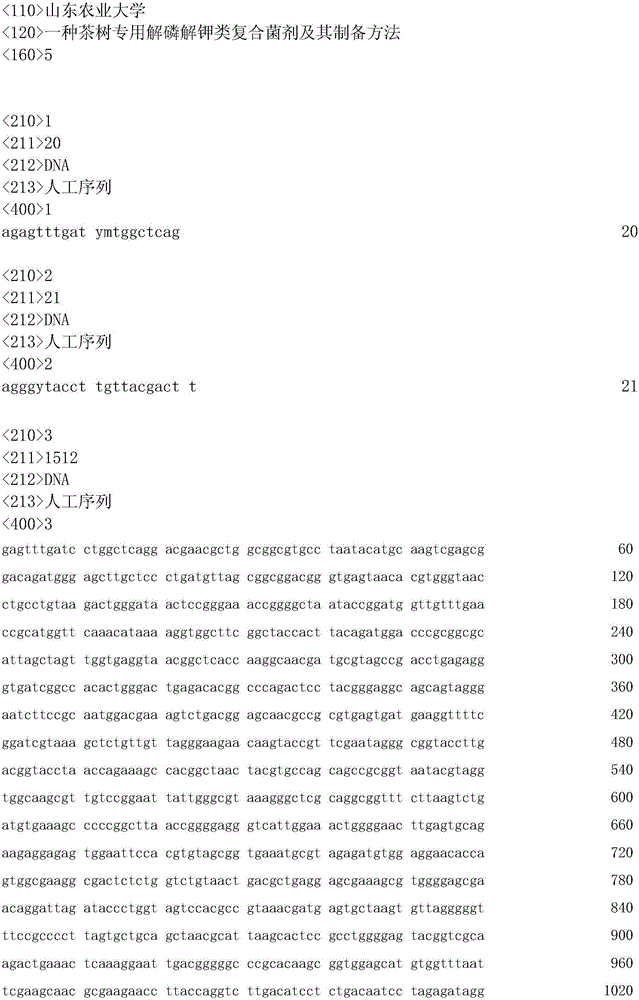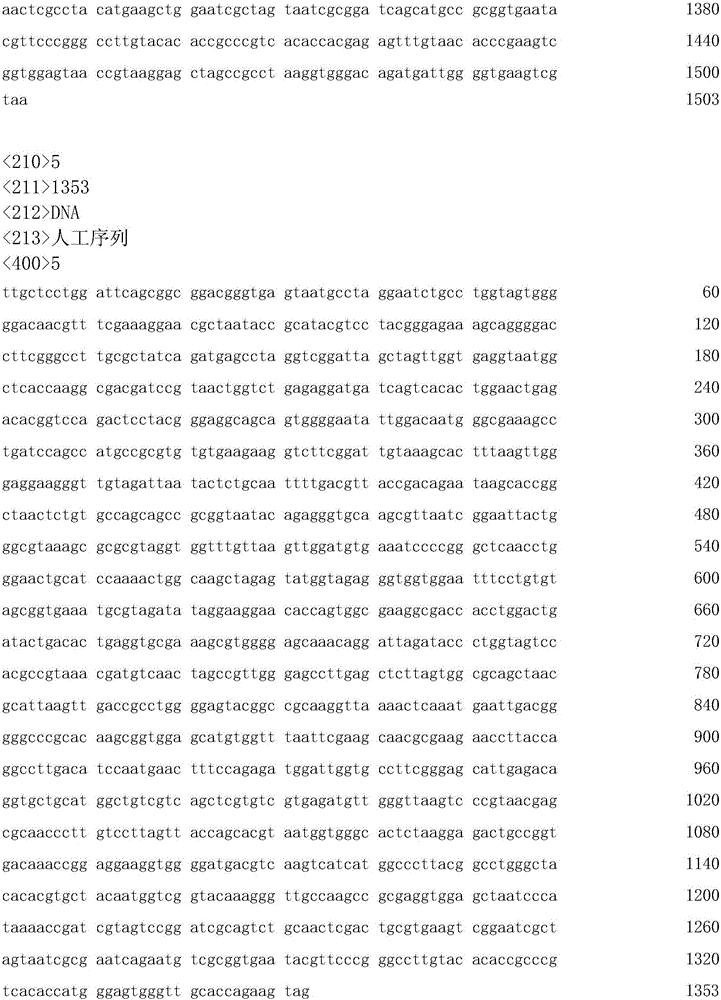Phosphate-solubilizing potassium-solubilizing complex microbial agent special for tea trees and preparation method of phosphate-solubilizing potassium-solubilizing complex microbial agent
A compound bacterial agent and potassium solution technology, applied in the field of microorganisms, can solve problems such as poor effect and inability to meet the growth needs of tea trees in the north
- Summary
- Abstract
- Description
- Claims
- Application Information
AI Technical Summary
Problems solved by technology
Method used
Image
Examples
Embodiment 1
[0013] Embodiment 1, the separation and identification of special potassium-solubilizing bacteria K2 for tea trees
[0014] The inventor collected soil samples from tea gardens in Shandong, placed them in sterile bags for low-temperature preservation, and brought them back to the laboratory for preservation at 4°C. Utilize potassium-solubilizing bacteria medium (yeast extract 0.5g, sucrose 10g, (NH 4 ) 2 SO 4 1.0g, Na 2 HPO 4 2.0g, MgSO 4 ·7H 2 O 0.5g, CaCO 3 1.0g, potassium feldspar powder 1.0g, dilute to 1000mL, adjust pH to 7.0-7.5) Screen target strains from soil. Combining traditional morphological, physiological and biochemical characteristics with PCR-based modern technology, the cultured strains were classified and identified, and finally a potassium-dissolving strain was screened.
[0015] According to the physiological and biochemical characteristics of the strain, it is found that the strain is Gram-positive, aerobic, positive for catalase and V-P, can us...
Embodiment 2
[0020] Example 2, the separation and identification of special inorganic phosphorus-decomposing bacteria WP2 for tea trees as an example
[0021] The inventors of the present invention collected soil samples from tea gardens in Shandong, placed them in sterile bags for low-temperature preservation, and brought them back to the laboratory for preservation at 4°C. Using inorganic phosphorus medium (glucose 10.0g, (NH 4 ) 2 SO 4 0.5g, NaCl 0.3g, KCl 0.3g, FeSO 4 ·7H 2 O0.03g, MgSO 4 ·7H 2 O 0.3g, MnSO 4 4H 2 O 0.03g, yeast extract 0.4g, Ca 3 (PO 4 ) 2 10.0g, dilute to 1000mL with deionized water, adjust the pH value to 7.0-7.5) cultivate and screen the target strain from the soil. Combining traditional morphological, physiological and biochemical characteristics with PCR-based modern technology, the cultured strains were classified and identified, and finally an inorganic phosphorus decomposing bacterium was screened out.
[0022] According to morphological observat...
Embodiment 3
[0027] Embodiment 3, take the separation and identification of the special organophosphorus decomposing bacteria YP8 for tea tree as an example
[0028] The inventors of the present invention collected soil samples from tea gardens in Shandong, placed them in sterile bags for low-temperature preservation, and brought them back to the laboratory for preservation at 4°C. Using organic phosphorus medium (glucose 10g, (NH 4 ) 2 SO 4 0.5g, NaCl 0.3g, KCl 0.3g, FeSO 4 ·7H 2 O0.03g, MgSO 4 ·7H 2 O 0.3g, MnSO 4 4H 2 O 0.03g, CaCO 3 5g, appropriate amount of lecithin, dilute to 1000mL, adjust the pH to 7.0-7.5) Screen the target strain from the soil. Combining traditional morphological, physiological and biochemical characteristics with PCR-based modern technology, the cultured strains were classified and identified, and finally an organophosphate-decomposing bacterium was screened out.
[0029] After morphological observation, it was found that the colony of the organophos...
PUM
 Login to View More
Login to View More Abstract
Description
Claims
Application Information
 Login to View More
Login to View More - R&D Engineer
- R&D Manager
- IP Professional
- Industry Leading Data Capabilities
- Powerful AI technology
- Patent DNA Extraction
Browse by: Latest US Patents, China's latest patents, Technical Efficacy Thesaurus, Application Domain, Technology Topic, Popular Technical Reports.
© 2024 PatSnap. All rights reserved.Legal|Privacy policy|Modern Slavery Act Transparency Statement|Sitemap|About US| Contact US: help@patsnap.com










